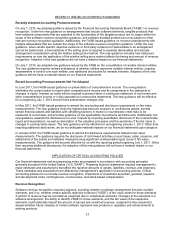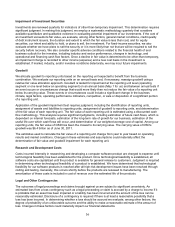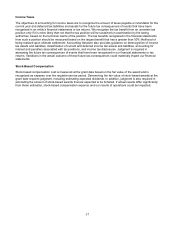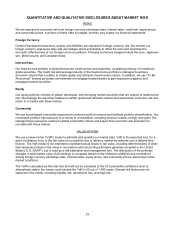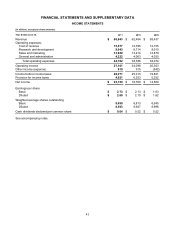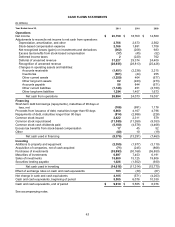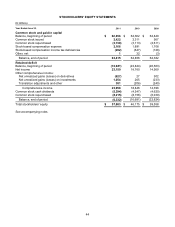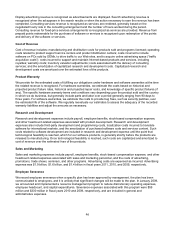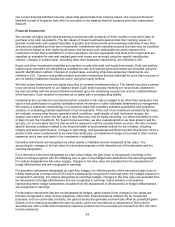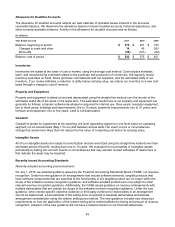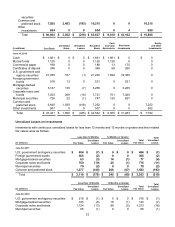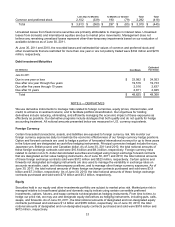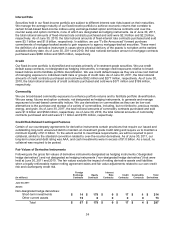Microsoft 2011 Annual Report Download - page 45
Download and view the complete annual report
Please find page 45 of the 2011 Microsoft annual report below. You can navigate through the pages in the report by either clicking on the pages listed below, or by using the keyword search tool below to find specific information within the annual report.
45
NOTES TO FINANCIAL STATEMENTS
NOTE 1 — ACCOUNTING POLICIES
Accounting Principles
The financial statements and accompanying notes are prepared in accordance with accounting principles
generally accepted in the United States of America (“U.S. GAAP”).
Principles of Consolidation
The financial statements include the accounts of Microsoft Corporation and its subsidiaries. Intercompany
transactions and balances have been eliminated. Equity investments through which we exercise significant
influence over but do not control the investee and are not the primary beneficiary of the investee’s activities are
accounted for using the equity method. Investments through which we are not able to exercise significant
influence over the investee and which do not have readily determinable fair values are accounted for under the
cost method.
Estimates and Assumptions
Preparing financial statements requires management to make estimates and assumptions that affect the reported
amounts of assets, liabilities, revenue, and expenses. Examples include: estimates of loss contingencies, product
warranties, product life cycles, product returns, and stock-based compensation forfeiture rates; assumptions such
as the elements comprising a software arrangement, including the distinction between upgrades/enhancements
and new products; when technological feasibility is achieved for our products; the potential outcome of future tax
consequences of events that have been recognized in our financial statements or tax returns; estimating the fair
value and/or goodwill impairment for our reporting units; and determining when investment impairments are other-
than-temporary. Actual results and outcomes may differ from management’s estimates and assumptions.
Foreign Currencies
Assets and liabilities recorded in foreign currencies are translated at the exchange rate on the balance sheet date.
Revenue and expenses are translated at average rates of exchange prevailing during the year. Translation
adjustments resulting from this process are recorded to Other Comprehensive Income (“OCI”).
Revenue Recognition
Revenue is recognized when persuasive evidence of an arrangement exists, delivery has occurred, the fee is
fixed or determinable, and collectibility is probable. Revenue generally is recognized net of any taxes collected
from customers and subsequently remitted to governmental authorities.
Revenue for retail packaged products, products licensed to original equipment manufacturers (“OEMs”), and
perpetual licenses under certain volume licensing programs generally is recognized as products are shipped or
made available. Revenue for products under technology guarantee programs, which provide free or significantly
discounted rights to use upcoming new versions of a software product if an end user licenses existing versions of
the product during the eligibility period, is allocated between existing product and the new product, and revenue
allocated to the new product is deferred until that version is delivered. The revenue allocation is based on vendor-
specific objective evidence of fair value of the products.
Certain multi-year licensing arrangements include a perpetual license for current products combined with rights to
receive future versions of software products on a when-and-if-available basis (“Software Assurance”) and are
accounted for as subscriptions, with billings recorded as unearned revenue and recognized as revenue ratably
over the billing coverage period. Revenue from certain arrangements that allow for the use of a product or service
over a period of time without taking possession of software are also accounted for as subscriptions. Revenue for
software products where customers have the right to receive unspecified upgrades/enhancements on a when-
and-if-available basis and for which vendor-specific objective evidence of fair value does not exist for the
upgrades/enhancements is recognized on a straight-line basis over the estimated life of the software.
Revenue related to our Xbox 360 gaming and entertainment console, Kinect for Xbox 360, games published by
us, and other hardware components is generally recognized when ownership is transferred to the resellers.
Revenue related to games published by third parties for use on the Xbox 360 platform is recognized when games
are manufactured by the game publishers.


